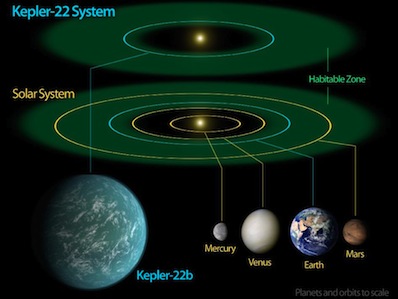



|

|

Kepler finds planet in the habitable zone
KEITH COOPER
ASTRONOMY NOW
Posted: 05 December 2011


The planet-finding Kepler space mission has discovered a planet 2.4 times the diameter of Earth in the liquid water habitable zone of a star 600 light years away. This is the first confirmed planet in the habitable zone of a star to be found by Kepler, but many more may be on the way.

Artist's impression of Kepler-22b, a planet known to comfortably circle in the habitable zone of a Sun-like star. Image: NASA/Ames/JPL-Caltech.
Kepler discovers planets by watching for their transits and detecting the dip in light as the planet passes in front of its star. The NASA mission’s latest haul now brings up the total number of candidate planets it has discovered to 2,326, incorporating 207 that are approximately Earth-sized, 680 that are super-earth sized (1.25 to two times the diameter of Earth), 1,181 that are Neptune-sized, 203 Jupiter-sized and 55 even larger than Jupiter. Forty-eight reside in the habitable zone, a ‘Goldilocks’ region where temperatures for planets with atmospheres are not too cold, not too warm, but just right for liquid water to flow. Ten of these 48 candidates are approximately Earth-sized.
“We believe we have some very viable candidates that are Earth-sized and in the habitable zone,” says Natalie Batalha, Kepler’s deputy science team leader from NASA’s Ames Research Center. However, these are candidates – they require further measurements to confirm them.
One planet that has been newly confirmed is Kepler 22b, a planet 2.4 times the diameter of Earth, orbiting its G-type star every 290 days. “Kepler 22b is exciting for two reasons; one, because it is right smack in the middle of the habitable zone,” says Batalha. “The second really exciting reason is that it is orbiting a star very similar to our own Sun, it’s a solar twin.”

Our own Solar System compared to Kepler-22, showing the position of Kepler-22b in the habitable zone around its star. Image: NASA/Ames/JPL-Caltech.
Although the planet lies 15 percent closer to its star than Earth does to the Sun, Kepler 22b’s star is a little dimmer and cooler than the Sun, so the planet can get away with being a bit closer. However, exactly what this planet is like is a bit of a mystery: being in the habitable zone isn’t enough to state that a planet is habitable – it requires an atmosphere for starters. Worlds of this size are however a bit of a mystery at the moment.
“We have no planets like this in our Solar System that lie between Earth-sized and Neptune-sized,” says Batalha. However, there is a good chance that it could be rocky, and possibly even rich in water, but the only way to determine its more vital characteristics is to measure its mass and then confirm its density. This can be achieved by ground-based observatories such as the ten-metre Keck telescopes measuring the radial velocity of the Kepler 22 star.
Kepler first spotted a transit of Kepler 22b only three days after the satellite went operational in 2009, but three transits were required to confirm the exoplanet’s existence, which is why it has taken so long to announce its existence. So far there has been no sign of the presence of other worlds in the system. Nevertheless, Kepler-22b is a watershed moment for the mission, with the promise of more to follow.
|

|

|

|
|



